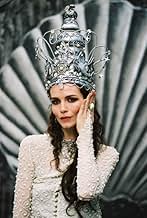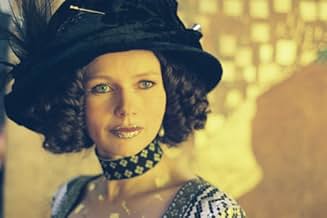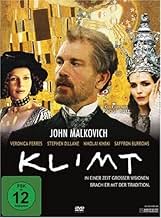अपनी भाषा में प्लॉट जोड़ेंA portrait of Austrian artist Gustav Klimt, whose lavish, sexual paintings came to symbolize the art nouveau style of the late nineteenth and early twentieth century.A portrait of Austrian artist Gustav Klimt, whose lavish, sexual paintings came to symbolize the art nouveau style of the late nineteenth and early twentieth century.A portrait of Austrian artist Gustav Klimt, whose lavish, sexual paintings came to symbolize the art nouveau style of the late nineteenth and early twentieth century.
- निर्देशक
- लेखक
- स्टार
- पुरस्कार
- 1 जीत और कुल 4 नामांकन
फ़ीचर्ड समीक्षाएं
Gustav Klimt (1862 - 1918) was a strange artist, a man who believed in a sensualist artificial religion and an artist who favored erotic imagery in his canvases. He was controversial in his time, yet today his paintings using gold leaf and silver leaf and design patterns of expression that defined Art Nouveau sell for many millions of dollars: his style is still imitated and he is still celebrated as the father of erotic art. The film opens and closes with Klimt (John Malkovich) submerged in healing waters in a rather stark hospital, attended by a nurse and his disciple, the equally sensational Egon Schiele (Nicolai Kinski, keeping his hands in the spread-finger style Schiele painted so often!). From this point bits and pieces of Klimt's bizarre life are explored, at times explained through imaginary conversations with his secretary (Stephen Dillane). His marriage, his 'affair' - or is it simply a manifestation of the influence of a muse? - with Lea de Castro (Saffron Burrows), his self indulgence in all things erotic (he is said to have has many affairs with Viennese women yielding a large number of children who bear his genetic puzzle), and his conflict with the Academy of Art, a sense of disgust with the current oeuvre of painting as sterile, and his prodigious output of paintings and drawing of the female nude - all are depicted with tremendous imagination here. The cinematography is as strange as the story it captures, using falling snowflakes in one scene to suggest the falling pieces of Klimt's gold leaf enhancement of his most famous works in others.
The dialogue is at times raw and at other times superficial and the audience is begged to indulge in the fantasy that is being recreated. But the film stands well as an example of an art history period and John Malkovich makes a credible Klimt. This is more a film for art students and art lovers who are eager to explore the beginnings of Art Nouveau than a film for audiences eager for accurate biography.
Grady Harp
There's a commonality among those two and Klimt, and even between them and the more cerebral Budapest next generation. Its a matter of passion, sense (in both meanings) and concept curvature. While the two great art nouveau geniuses were wondering about space in Brussels and Barcelona, Klimt worked his space, curvature ans escape from the inside of women. Lots of women.
His work is of that type that is immediately attractive, so lots of people decorate with it. A brief familiarity with it breeds confusion, so unless you dig as deeply in viewing as he did in making, it will not connect. As a result, if you are serious about making a film of him, about him, you simply cannot do the normal thing: somehow artificially inducing drama into portraying a few known events. You cannot do what Greenaway did with Rembrandt, simply showing sexual passion and making the film painterly.
So along comes Ruiz, who is a strange bird, very much like Klimt. There's no middle familiarity with him. Either you know him deeply, you wrap your life where he has, or you miss the passion. You think him dull. You actually believe that someone would spend this much energy fine tuning the ordinary. Well, the thing about these three men is that they were their own worst critics. They all three created their own new worlds were none was before, worlds so perfect and pure anyone of lesser power would be unable to break them. Then they each turned on their own creation, finding and exploiting the weaknesses of their own creations, selves and now us. The art is not in the man but in how he made himself broken.
Look at each of them and see the beauty in partial dismemberment. Ruiz denotes this at the beginning with otherwise inexplicable, powerful amputee sex. As with Ruiz' best work, people act as others, split selves, whores of themselves, auditors and bureaucrats of sex. Love must be dissymmetric. Narrative to have power must be a bit jagged inside, where you want to go.
I admit, I think Malkovich was a bad choice. He really can be dull. But he is supposed to stagger through this, finding puddles of warm light, clean frames or open enclosure. The women are the thing, always the thing here and they are drawn well.
Ted's Evaluation -- 3 of 3: Worth watching.
Hunter S. Thompson blew the journalistic world away by openly reporting events through the prism of his own drug-soaked experience. Terry Gilliam's cinematic portrayal of this in "Fear and Loathing in Las Vegas" conveyed this brilliantly.
So far as I know, Gustav Klimt did not portray his artistic vision in an ether-soaked stupor or in a state of syphilitic delirium. My problem with Mr. Ruiz portraying him as though he did is that Klimt actually led an exuberant revolutionary artistic movement in a city and continent exploding with creative energy, and this portrayal could hardly be farther from the truth. Even a non-linear poetic portrayal of the creative process should shed some truth on its essence.
The tone of the movie was static, suffocating, semi-conscious and joyless. Klimt's life was full of color, sexual experimentation and living life to its fullest, so it additionally seems odd that John Malkovich sleepwalks through his performance with less joy than Rod Steiger in "The Pawnbroker."
If Mr. Ruiz wanted to make a film about a fever-dream (Klimt died of pneumonia following a stroke, not of tertiary syphilis as suggested in the film), perhaps he should have entitled it "Fever-Dream: with a whimsical guest appearance by my fantasy of Gustav Klimt."
This film may be of use to film students to prove that images and sound do not automatically add up to a movie.
The movie is decorated with dozens of naked women who mainly parade about, or who try to seduce Klimt. Given that he is not particularly handsome, charming or intelligent, I failed to see the attraction. Perhaps it was just his fame as a painter.
The interiors and costumes are opulent turn of the century Vienna. Elaborate Viennese pastries tempt the eye. The sets are the main appeal of the movie.
There is a lot of cat and mouse dialogue where the characters reveal nothing and say nothing while attempting to sound profound. It is all quite frustrating.
Nikolai Kinski plays the homosexual painter Egon Schiele in an exaggeratedly swish way, reminiscent of Da'an's hand gestures in Earth Final Conflict.
The costumes and hair treatments are so elaborate, that I could not for the life of me tell the female characters apart. Is this a new character or an old one in a new do? The characters all behave the same way and look similar. I didn't develop any bond with any of the characters because I could not even tell them apart.
क्या आपको पता है
- ट्रिवियाRyan Phillippe was considered for the role of Klimt.
- गूफ़When Klimt mashes the cake in the man's face, the icing on the man's face is not covering his right eye. In the next close-up shot, there is a large blob of icing covering the man's right eye. In the next long shot when Klimt starts to wipe the man's face, the icing is no longer covering the man's right eye again.
- भाव
Klimt: Who art thou Asked the guardian of the night From crystal purity I come Was my reply And great my thirst, Persephone Yet heeding thy decree I take to flight and turn, and turn again Forever right I spurn the pallid cypress tree Seek no refreshment at its sylvan spring but hasten on toward the rustling river of Mnemosyne Wherein I drink to sweet satiety And there, dipping my palms between The knots and loopings of its mazy stream I see again, as in a drowning swimmers dream All the strange sights I ever saw And even stranger sights no man has ever seen
- इसके अलावा अन्य वर्जनA 131-minute-long Director's Cut was released theatrically in Austria and is available on DVD in the UK.
- कनेक्शनReferenced in Ricardo Aronovich, avec mes yeux de dinosaure du cinéma (2011)
टॉप पसंद
- How long is Klimt?Alexa द्वारा संचालित
विवरण
- रिलीज़ की तारीख़
- कंट्री ऑफ़ ओरिजिन
- आधिकारिक साइटें
- भाषाएं
- इस रूप में भी जाना जाता है
- A Viennese Fantasy à la manière de Schnitzler
- फ़िल्माने की जगहें
- उत्पादन कंपनियां
- IMDbPro पर और कंपनी क्रेडिट देखें
बॉक्स ऑफ़िस
- US और कनाडा में सकल
- $97,656
- US और कनाडा में पहले सप्ताह में कुल कमाई
- $2,332
- 24 जून 2007
- दुनिया भर में सकल
- $5,84,991
- चलने की अवधि
- 2 घं 11 मि(131 min)
- रंग
- ध्वनि मिश्रण
- पक्ष अनुपात
- 1.85 : 1




































